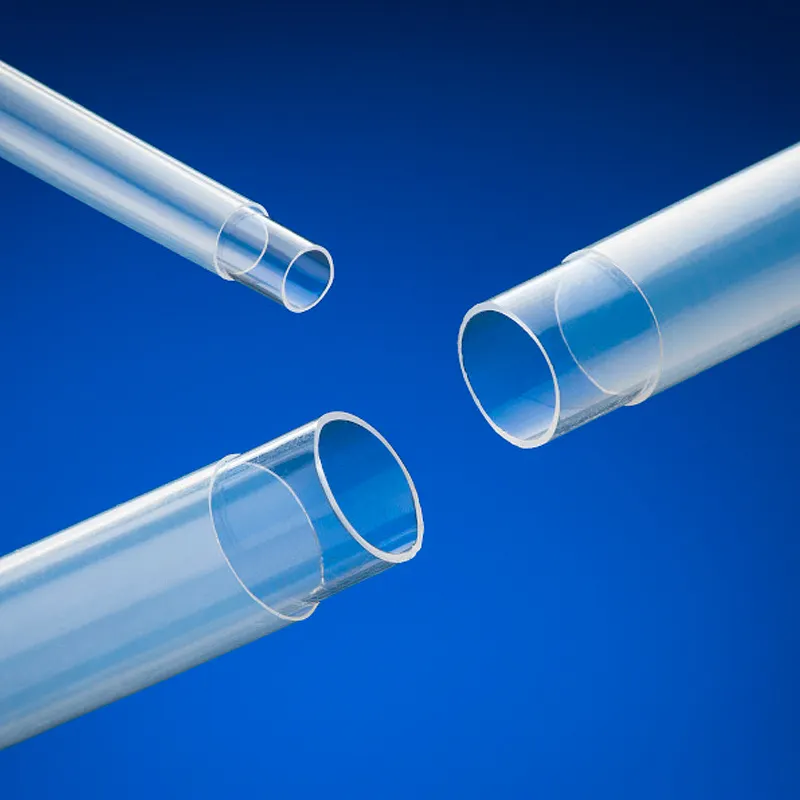FEP vs PTFE vs PFA Heat Shrink Tubing: A Data-Driven Comparison for Critical Applications
November 27, 2025
Fluoropolymer Schrumpfschlauch is essential for protecting components in high-performance environments. Among the available materials—FEP, PTFE, and PFA—each offers unique thermal, chemical, and mechanical characteristics. However, choosing between them can be challenging without clear side-by-side engineering data.
This article provides a technical comparison based on shrinkability, dielectric behavior, purity, mechanical strength, and application suitability. The data reflects testing methods and manufacturing standards used in Yozonetech’s cleanroom production for semiconductor and medical clients.

1. Shrinkability & Processing Temperature
FEP shrinks easily; PTFE and PFA require far higher temperatures.
Shrink Temperature Comparison
| Pre-Shrink Thickness | Post-Shrink Average | Reduction Rate |
| 0.20 mm | 0.16 mm | -20% |
| 0.30 mm | 0.26 mm | -13% |
| 0.50 mm | 0.44 mm | -12% |
FEP is ideal when you need low thermal shock. PTFE/PFA are preferred for ultrahigh-temperature systems.
2. Purity & Chemical Resistance
All three materials offer excellent chemical resistance, but PFA-Schläuche and FEP are preferred for semiconductor equipment due to extractables and ionic contamination metrics.
Purity Comparison Table
| Stage | Temperature | Duration | Purpose |
| Pre-heat | 110-150°C | 20-40 sec | Remove moisture & reducethermal shock |
| Controlled Shrink | 180-210°C | 30-80 sec | Uniform recovery |
| Stabilization | 230-260°C | 10-20 sec | Maximize clarity & molecular alignment |
Yozonetech uses resin filtration and Class 7 packaging to meet semiconductor OEM requirements.
3. Mechanical Strength
PTFE is the strongest; FEP is the most flexible.
Mechanical Properties
| Parameter | Typical Value | Why it Matters |
| Zugfestigkeit | 20-29 MPa | Withstand mechanicalstress during shrink &operation |
| Elongation | 260-320% | Ensures flexibility oversharp bends |
| Dielektrische Festigkeit | 16-22 kV/mm | Prevents electricalbreakdown |
| Max Continuous Use Temp | 200°C | High-temperature environments |
This affects handling during shrink and long-term durability.
4. Dielectric Performance
| Material | Dielektrische Festigkeit | Dielectric Constant | Notes |
| FEP | 16-22 kV/mm | 2.1 | Excellent consistency |
| PFA | 15-20 kV/mm | 2.1 | Slightly higher variation |
| PTFE | 18-25 kV/mm | 2 | Best high-temperature stability |
All three are strong insulators; FEP tubing is the most stable under moisture and chemical variance.
5. Application Suitability Summary
Where Each Material Performs Best
| Application Type | FEP | PFA | PTFE |
| Semiconductor WetProcess | √ | √ Best | - |
| High-Temperature Wiring | √ Best | √ | √ Best |
| Medical TubingEncapsulation | √ | √ | - |
| chemical Transfer Systems | √ | √ Best | √ |
| recision sensors | √ Best (flexibility) | √ | - |
Schlussfolgerung
FEP, PTFE, and PFA each offer distinct advantages.
- FEP: Best balance of flexibility, purity, ease of shrinking
- PFA: Best for ultraclean and high-temperature semiconductor systems
- PTFE: Best for extreme thermal environments
Understanding these differences allows engineers and procurement teams to choose materials based on performance, cost, and processing conditions. Yozonetech supports all three solutions, supplying cleanroom-grade heat shrink tubing with strict dimensional and purity controls.
 +86-13752771911
+86-13752771911 E-mail:ptfetube@yozonetech.cn
E-mail:ptfetube@yozonetech.cn


